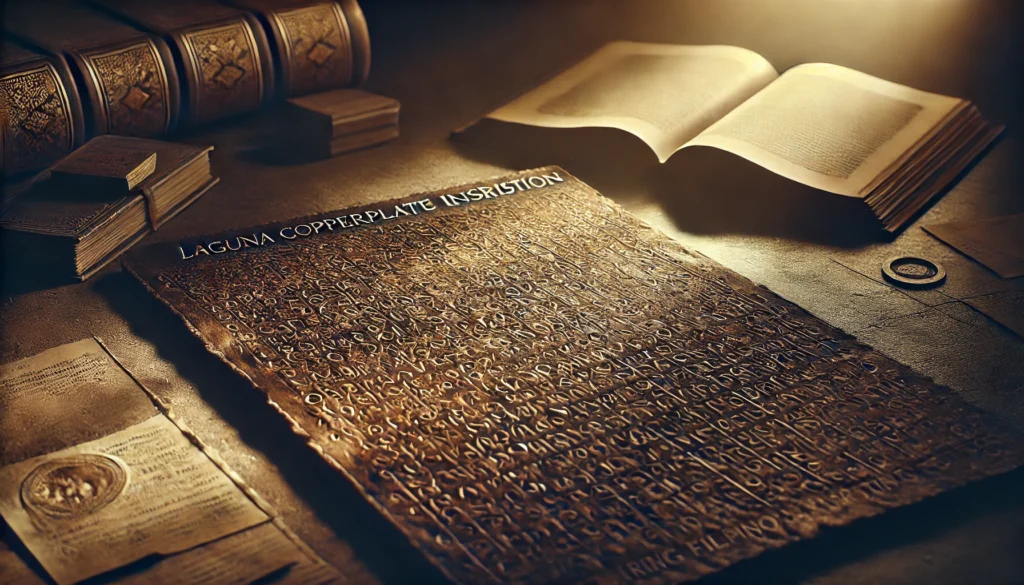The Laguna Copperplate Inscription (LCI) stands as a pivotal artifact in Philippine history, shedding light on the archipelago’s pre-colonial past. Discovered in 1989 near the mouth of the Lumbang River in Laguna de Bay, this copper plate has revolutionized our understanding of early Filipino society, governance, and writing systems.
Historical Context
The LCI dates back to 900 CE, making it one of the oldest written documents found in the Philippines. Its discovery challenged previous notions about the absence of writing in pre-colonial Philippines and provided concrete evidence of a sophisticated civilization existing long before Spanish colonization.
Physical Description
- Material: Copper
- Dimensions: 20 cm x 30 cm
- Weight: Approximately 226 grams
- Inscribed text: 18 lines of writing
The plate’s remarkable preservation over a millennium speaks to the durability of copper as a writing medium and the favorable environmental conditions that protected it from decay.
Deciphering the Text
The inscription on the copper plate presented a significant challenge to historians and linguists. Its decipherment has been a collaborative effort involving experts from various fields.
Language and Script
The text is primarily written in Old Malay, using a script derived from the Kavi script of Java. This linguistic connection highlights the extensive maritime trade networks that linked the Philippines with other Southeast Asian cultures during this period.
Translation Process
- Initial attempts at translation were made by Filipino historians
- Dutch anthropologist Antoon Postma provided the first comprehensive translation in 1992
- Subsequent refinements have been made by linguistics experts
The collaborative nature of the translation process underscores the importance of interdisciplinary approaches in historical research.
Content and Interpretation
The Laguna Copperplate Inscription provides a wealth of information about early Filipino society, offering insights into various aspects of life in 900 CE.
Key Information Contained in the LCI
- Date: The inscription is precisely dated to 900 CE
- Locations: Mentions several places, including Tondo and Puliran
- Names: Lists several individuals and their titles
- Legal matter: Describes the cancellation of a debt
- Social structure: Implies a hierarchical society with various ranks and titles
Societal Insights
The LCI reveals a complex society with established legal systems, social hierarchies, and economic practices. It suggests that early Filipino communities were engaged in sophisticated trade and had developed systems of governance and justice.
Historical Implications
The discovery and decipherment of the Laguna Copperplate Inscription have had far-reaching implications for our understanding of Philippine history and Southeast Asian connections.
Pre-colonial Philippine Society
- Challenges the notion of a primitive pre-colonial Philippines
- Demonstrates the existence of a literate, organized society
- Suggests a level of political and economic sophistication previously unrecognized
Regional Connections
The use of Old Malay and a Javanese-derived script points to strong cultural and economic ties with other Southeast Asian polities. This evidence supports theories of extensive maritime trade networks that facilitated cultural exchange across the region.
Historiographical Impact
The LCI has necessitated a reevaluation of Philippine historiography, particularly regarding the pre-colonial period. It has spurred increased interest in and research on early Filipino writing systems and cultural practices.
Comparative Analysis
To better understand the significance of the Laguna Copperplate Inscription, it’s helpful to compare it with other ancient writing systems and artifacts from the region.
| Artifact | Origin | Date | Script | Material |
|---|---|---|---|---|
| Laguna Copperplate | Philippines | 900 CE | Kavi-derived | Copper |
| Kedukan Bukit Inscription | Indonesia | 683 CE | Old Malay | Stone |
| Telaga Batu Inscription | Indonesia | 7th century CE | Old Malay | Stone |
| Taiping Ching Chiu Inscription | Malaysia | 1345 CE | Chinese | Stone |
This comparison highlights the LCI’s unique position as one of the earliest dated inscriptions in the Philippines and its connection to broader Southeast Asian writing traditions.
Linguistic Analysis
The language and script used in the Laguna Copperplate Inscription provide valuable insights into the linguistic landscape of early medieval Southeast Asia.
Old Malay Features
- Vocabulary: Many words recognizable in modern Malay and Indonesian
- Grammar: Reflects archaic forms of Malay syntax
- Loanwords: Includes Sanskrit-derived terms, indicating Indian cultural influence
Script Characteristics
- Derived from the Kavi script of Java
- Shows similarities to other Southeast Asian scripts of the period
- Demonstrates the spread and adaptation of writing systems across maritime Southeast Asia
The linguistic analysis of the LCI has contributed significantly to our understanding of language evolution and diffusion in the region.
Archaeological Context
The discovery of the Laguna Copperplate Inscription has spurred renewed interest in archaeological investigations in the Philippines, particularly in the Laguna de Bay area.
Related Finds
- Pottery shards with similar dating
- Metal tools and ornaments
- Trade goods from other parts of Southeast Asia
These archaeological findings provide a material context for the society described in the LCI, supporting the textual evidence with physical artifacts.
Controversies and Debates
As with many significant historical discoveries, the Laguna Copperplate Inscription has not been without its share of controversies and scholarly debates.
Authenticity Questions
- Initial skepticism about the artifact’s authenticity
- Scientific tests confirming the age and composition of the copper plate
- Ongoing discussions about potential forgery techniques
Interpretative Disputes
- Disagreements over specific translations of words and phrases
- Debates about the precise nature of the social and political structures mentioned
- Questions about the extent of foreign influence implied by the inscription
These debates highlight the complex nature of interpreting ancient texts and the importance of ongoing scholarly dialogue in refining our understanding of historical evidence.
Impact on Philippine National Identity
The Laguna Copperplate Inscription has had a profound impact on Philippine national identity and historical consciousness.
Cultural Pride
- Reinforces a sense of ancient Filipino civilization
- Challenges colonial narratives of cultural inferiority
- Inspires renewed interest in pre-colonial Philippine history
Educational Impact
- Inclusion in school curricula
- Increased focus on early Philippine writing systems in universities
- Stimulation of public interest in archaeology and ancient history
The LCI has become a symbol of Filipino cultural achievement and historical continuity, fostering a deeper appreciation for the nation’s rich heritage.
Preservation and Exhibition
The preservation and public display of the Laguna Copperplate Inscription are crucial for its continued study and appreciation.
Conservation Efforts
- Careful cleaning and stabilization of the copper plate
- Climate-controlled storage to prevent further degradation
- Regular monitoring by conservation experts
Public Access
- Exhibited at the National Museum of the Philippines
- High-quality replicas created for study and display
- Digital scans and photographs made available for researchers worldwide
These preservation and exhibition efforts ensure that this invaluable artifact remains accessible for future generations of scholars and the general public.
Future Research Directions
The study of the Laguna Copperplate Inscription continues to evolve, with several promising avenues for future research.
Potential Areas of Investigation
- Advanced imaging techniques to reveal more details of the inscription
- Comparative studies with newly discovered artifacts from the region
- Interdisciplinary approaches combining linguistics, archaeology, and historical analysis
Technological Applications
- Use of AI and machine learning in deciphering ancient scripts
- 3D modeling and virtual reality for enhanced visualization and study
- Development of databases linking related artifacts and inscriptions
These research directions hold the potential to further deepen our understanding of the LCI and its historical context.
Conclusion
The Laguna Copperplate Inscription stands as a testament to the rich and complex history of the Philippines. Its discovery and ongoing study have transformed our understanding of pre-colonial Filipino society, challenging long-held assumptions and opening new avenues for historical research. As we continue to unravel its secrets, the LCI serves as a bridge to our ancient past, offering invaluable insights into the cultural, linguistic, and political landscape of early medieval Southeast Asia.
Disclaimer: While every effort has been made to ensure the accuracy of the information presented in this blog post, our understanding of ancient artifacts and historical contexts is continually evolving. Readers are encouraged to report any inaccuracies or new information to the author for prompt review and correction. This content reflects the state of knowledge up to 2023 and may be subject to updates as new research emerges.




